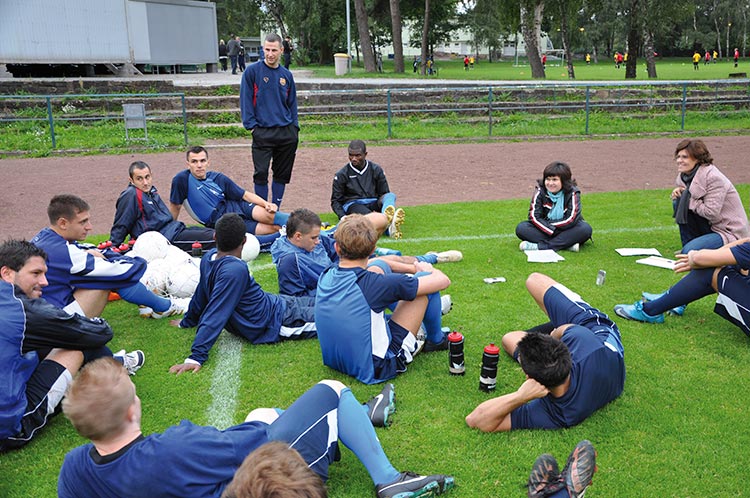DE
Ein LED-Ticker läuft am oberen Rand der östlichen Flurwand im Erdgeschoss, von der hinteren Glastür bis zum Eingangsbereich (Richtung Nord-Ost) entlang. Die 50 mm hohe LED-Schrift ist rot. Die Wand ist in ihrer gesamten Höhe und Länge rot gestrichen.
Kunst am Bau von, mit und für die Nutzer des Gebäudes
Im Sommer 2010 und Herbst 2013 wurden Gespräche mit den Sportlern durchgeführt, die
die Julius-Hirsch-Sportanlage und somit auch das Funktionsgebäude
nutzen. Es ging dabei um die Verbindung zwischen Sport und Politik,
um Vorurteile bezüglich der Herkunft, und auch um Julius Hirsch selbst, nach dem die Anlage benannt wurde.
Julius Hirsch (1892 – 1943) war deutschen Nationalspieler (1911
– 1913) und Fußballer des Karlsruher FV sowie der Spielvereinigung
Fürth. Er wurde 1943 aufgrund seiner jüdischen Herkunft nach Auschwitz-Birkenau deportiert und ermordet.
Ausschnitte aus den Gesprächen wurden ausgewählt. Sie werden mit
Hilfe der LED-Laufschrift im Flur des Sportfunktionsgebäudes ausgestrahlt, so dass die Sportler sie im Gebäude wieder finden, neu entdecken
und in ihrem Alltag immer wieder zur Reflexion eingeladen werden. Die
rote Farbe der Wand betont die Funktion der Laufschrift als Denkanstoß.
An den Gesprächen haben sich die 1. Herrenmannschaft des TuS Makkabi Berlin e.V., die 1. Herrenmannschaft des SCC e.V. und im Herbst 2013 auch die Junniorinnen des Tennis Borussia Berlin e.V. beteiligt. Mit der TeBe-Mannschaft konzentrierte sich das Gespräch auf das Thema der Diskriminierung von Frauen im Fußball.
Die Mitwirkung der Sportler_innen und ihre Aussagen bestimmen die Inhalte der Laufschrift. Der LED-Ticker und seine von den Nutzern des Gebäudes produzierten Inhalte verändern sich für den Betrachter stetig und laden immer
wieder neu zur Reflexion ein. Die Gespräche wurden in Zusammenarbeit
mit der Ethnologin Dr. Anja Peleikis vorbereitet und durchgeführt.
![]() Download Publication 2010 (in german, PDF 6,8 MB).
Download Publication 2010 (in german, PDF 6,8 MB).![]() Download Publication 2014 (in german, PDF 500 KB).
Download Publication 2014 (in german, PDF 500 KB).


